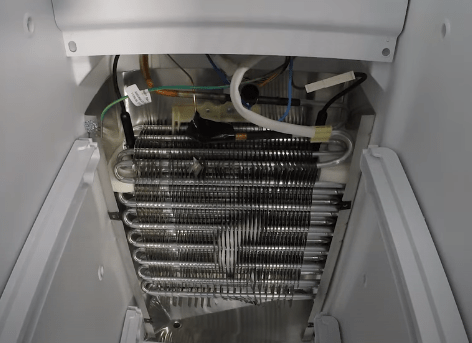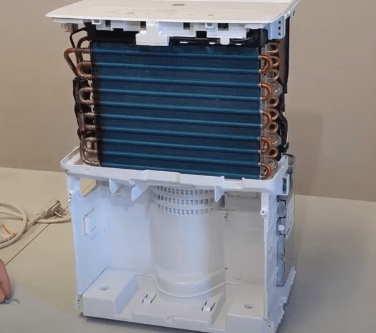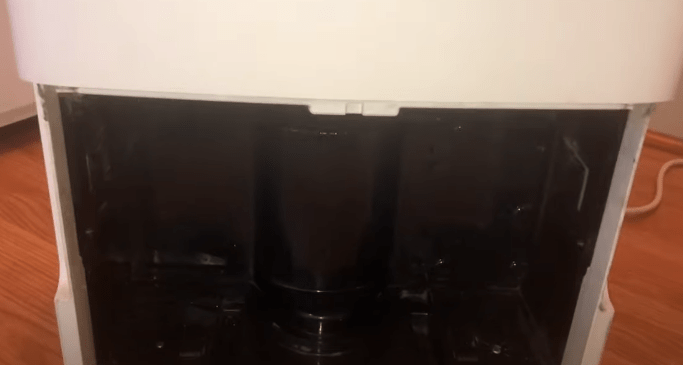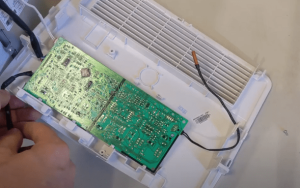In today’s fast-paced world, where our daily lives are often filled with hectic schedules and countless responsibilities, it’s easy to overlook the subtle details that can have a significant impact on our well-being.
Hi there, I’m Mannan Wasif, and I’m here to connect with you on a topic that might not always be top of mind but plays a crucial role in maintaining a healthy living environment – dehumidifiers. You see, just like you, I’ve experienced my fair share of tricks and problems when it comes to these devices, and I understand the frustration that can arise when they don’t quite work as expected.
Imagine this: You’re in the comfort of your home, seeking refuge from the outside world. The air is crisp, and you’re feeling relaxed until you notice something unusual—your trusty dehumidifier has started to ice up.
But fear not, because today I am diving deep into the mysteries of this common issue. I’ll uncover the reasons behind why does my dehumidifier ice up and explore some practical solutions to keep your indoor space comfortable and conducive to your well-being.
So, let’s embark on this journey together, as I unravel the enigma of dehumidifier icing and equip ourselves with the knowledge and tools to ensure that our living spaces remain not just habitable, but truly harmonious. Let’s get started.
Why is my dehumidifier icing up?
Unlocking the solution to the dehumidifier icing issue hinges on identifying the root causes behind the freezing coils, especially when your unit resides in the basement. Only when you grasp these underlying factors will you truly appreciate the significance of warding off future ice buildup. Are you prepared? Here are some of the typical culprits:
1. Running Below 65°F Temperature

The most common culprit behind your dehumidifier’s icy woes is chilly weather. Even if your dehumidifier can theoretically operate at lower temperatures, it’s typically capped at 65°F degrees.
When the mercury drops too low, the condenser coils start donning their icy coats. Fortunately, there’s a silver lining – the auto-frost mode. This nifty feature shuts off the compressor when the coils turn too cold, saving the day.
2. Faulty Humidity Sensor

Sometimes, the humidity sensor decides to play hide and seek. When this happens, the dehumidifier coils get a tad too frosty, potentially damaging the internal workings. The humidistat sensor, akin to a thermostat for humidity, is a pivotal component.
It keeps the dehumidifier’s anti-frost mode, or auto-deicing mode, in check. These signals are the lifeblood of preventing ice buildup. Once the ice retreats, the compressor kicks back into gear.
3. Faulty Bi-metal Thermostat

A misbehaving bi-metal thermostat can spell trouble when the room is chilly and the humidity is high. If there’s a short circuit or the electrical contacts that power the compressor circuit decide to weld themselves shut, you’ve got an ice-making machine.
This thermostat keeps a watchful eye on the temperature of the evaporator coil. Without an accurate reading, the compressor stubbornly refuses to de-ice the coils, leading to non-stop operation.
4. Faulty Fan Motor Or Blower Wheel

If you can’t hear a reassuring hum from your dehumidifier, blame it on the fan motor or blower wheel. These components are vital for ensuring proper airflow circulation and preventing condenser coils from freezing.
A silent fan is a red flag; it could mean a broken fan motor. Dust, dirt, or debris can also hinder smooth fan operation, potentially causing the fan blades to snap or become loose, further impeding airflow.
5. Clogged Air Filter

A clogged, dirty air filter is like a roadblock for your dehumidifier’s airflow, resulting in frosty coils. These filters trap dust, hair, and dirt particles from the air, serving as a shield for internal components.
Surprisingly, many folks are oblivious to their dehumidifiers having filters, or they simply overlook cleaning them. Neglecting the filter can obstruct the air’s flow, leading to malfunction.
6. Dirty Evaporator/ Condenser Coils

Debris buildup in the evaporator and condenser coils can also give rise to dehumidifier icing. Dust, dirt, hair, and lint that manage to bypass the filter can accumulate on these coils over time.
Regularly maintaining the air filter not only shields the coils from airborne invaders but also extends your dehumidifier’s lifespan.
7. Disruptive airflow

A blocked airflow can turn your dehumidifier into an icy marvel. Placing it too close to a wall or letting foreign objects obstruct the ventilation can cause this chilling issue.
8. Other Mechanical or Electrical Failures

When it rains, it pours. Refrigerant leaks, fried compressors, electronic control tantrums, faulty wiring, and broken switches can all contribute to ice buildup. Dehumidifiers rely on complex refrigeration systems that occasionally throw a wrench in the works. A single hiccup in any of these components can disrupt the entire system.
What can you do to stop it?
Is your dehumidifier giving you the cold shoulder by freezing up when it’s least expected? Fear not! We’ve got the lowdown on how to keep your trusty appliance ice-free. Here are some prevention methods to ensure your dehumidifier stays in tip-top shape:
1. Check the Temperature
Start by checking the temperature settings on your dehumidifier. If things are heating up too much, it can lead to moisture formation, a prime ingredient for icing woes. Adjust the temperature dial to a cooler setting if necessary to prevent your dehumidifier from freezing.
2. Check air flow
Uninterrupted airflow is the lifeblood of your dehumidifier’s moisture-removing prowess. Make sure there are no pesky obstructions in your unit’s vents or grills that could hinder its performance. If they’re caked with dirt, give them a good cleaning.
3. Check For debris and build up
Inspect your dehumidifier closely for any signs of debris or residue clogging up the evaporator coils and fins. During the winter months, this buildup can be a prime suspect behind ice formation, as it prevents your unit from emitting enough heat into the air.
4. Clean it
Even in seemingly clean environments, dehumidifiers can accumulate dust and dirt on their fins and evaporator coils over time. Ignoring this can seriously hamper your unit’s performance. Routinely check for buildup and remove it promptly to keep your dehumidifier running smoothly. Plus, clean coils mean enhanced efficiency in moisture removal.
5. Switch it off
Consider switching off your dehumidifier during periods of the day when temperatures are high and it’s prone to icing. This allows the coils to cool down, preventing the temperature from soaring to problematic levels.
Once your dehumidifier has had a breather, you can switch it back on or employ a timer to manage its operation. Keeping those coils clean and frost-free without a worry is one of the top tactics to ward off freezing issues.
Additional Tips and Troubleshooting
If your dehumidifier is icing up, it can be indicative of several issues that need to be addressed. Ice formation on the coils of a dehumidifier can reduce its efficiency and potentially damage the unit over time. Here are some additional tips and troubleshooting steps to help you understand and resolve this issue:
- Check the Temperature: Dehumidifiers are less effective in colder temperatures. If the room where your dehumidifier is placed is too cold (typically below 60°F or 15°C), the coils can freeze. Try to maintain a room temperature above this threshold if possible.
- Adjust the Humidity Setting: Sometimes, setting the humidity level too low can cause the dehumidifier to overwork, leading to ice buildup. Try setting the desired humidity level a bit higher to see if that prevents icing.
- Clean or Replace the Air Filter: A clogged or dirty air filter can restrict airflow, causing the unit to become less efficient and potentially leading to ice formation. Clean or replace the air filter regularly according to the manufacturer’s recommendations.
- Check for Obstructions: Make sure there are no obstructions blocking the air intake or exhaust vents of the dehumidifier. Adequate airflow is essential for proper operation.
- Inspect the Drainage System: Ensure that the drainage bucket or hose is not clogged or blocked. If water is not draining properly, it can lead to ice formation.
- Positioning: Make sure the dehumidifier is not placed too close to walls, furniture, or other objects. Proper spacing allows for better air circulation and can help prevent icing.
- De-Icing: If you notice ice buildup on the coils, turn off the dehumidifier and allow it to thaw. Use a towel or cloth to soak up any excess water. Once the ice has melted, restart the unit and monitor it closely.
- Regular Maintenance: Perform routine maintenance as recommended by the manufacturer. This may include cleaning the coils, checking the refrigerant levels, and ensuring all components are in good working order.
- Check for Refrigerant Leaks: If your dehumidifier continues to ice up despite regular maintenance, it’s possible that there is a refrigerant leak. In this case, you should contact a professional technician for repair.
- Consult the User Manual: Always refer to the user manual that came with your dehumidifier for specific troubleshooting tips and maintenance instructions. The manual may provide guidance on addressing icing issues specific to your unit.
- Environment: Consider the overall environmental conditions. If you live in an extremely humid climate, your dehumidifier may have to work harder and could be more prone to icing. In such cases, selecting a dehumidifier with appropriate capacity for your space may help.
Conclusion
Understanding why your dehumidifier ices up is crucial for maintaining its efficiency and preventing potential damage. By addressing the root causes and following preventive measures, you can ensure your dehumidifier keeps your home comfortable and moisture-free.
Discover why your dehumidifier ices up and learn how to prevent and troubleshoot this issue effectively. Keep your home dry and comfortable. Regular maintenance and environmental considerations are key to resolving and avoiding icing issues in the long term.

He is a mechanical engineer & our expert team member with over four years of experience who provides comprehensive and informative guides on various home improvement topics. From DIY projects to professional installations, he strives to give readers the knowledge and tools they need to make informed decisions and successfully complete their home improvement projects.
His goal is to empower homeowners to create the home of their dreams, while also increasing the value and functionality of their property. Whether you’re a first-time homeowner or a seasoned renovator, he has something for everyone.
